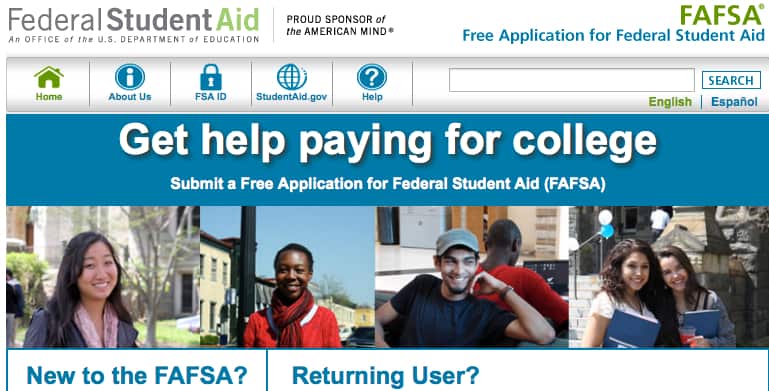
One of the most unpleasant aspects of filing for financial aid is how rushed the process has always been.
The Free Application for Federal Student Aid isn’t released until Jan. 1 each year, which has never given parents much time to file for financial aid. This is especially true since families need their tax returns finished before finalizing the FAFSA.
The aid deadlines for some state programs is February and many schools expect families to file for aid in that same time period.
With impossibly tight deadlines, families have often found themselves using estimated tax information when they’ve filed the FAFSA. If their estimates are wrong, however, their aid packages can end up being worse that they expected.
The admission cycle and the annual tax filing calendar have never been aligned. And  that has also forced students to apply to schools months before knowing if these institutions would be financially feasible.
that has also forced students to apply to schools months before knowing if these institutions would be financially feasible.
It’s been a terrible system, but thanks to an executive order signed this month by President Obama, it will soon be changing.
The change will be great news for most Americans, but there will be some losers during the transition period.
Upcoming FAFSA Changes
Here are some key things you need to know about the changes:
Switch to prior-prior taxes returns.
The parental scramble to file the FAFSA and get their taxes completed will soon no longer be an issue. Beginning with the 2017-2018 school year, students will be using prior-prior tax returns when completing the FAFSA.
Parents of students who will be in college in the fall of 2017, for example, will use their 2015 federal tax return to complete the FAFSA. Under the traditional system, these parents would have relied on their 2016 tax returns. So you can see that scrambling to complete their tax returns will no longer be an issue because of the reliance on an older tax return.
Taxes for 2015 will be doubly important.
As the system transitions to using prior-prior returns, many families will have to use their 2015 tax return twice. Parents will use the 2015 return if they are applying for aid for the 2016-2017 school year and the following year too.
Relying on the 2015 tax return twice won’t be an issue for parents whose incomes have remained stable during those two years. But it can be a terrible development for families who experienced a tremendous financial year in 2015 but not in 2016.
If your financial situation has changed since you filed your 2015 tax return, you can ask for a professional judgment from a school. College financial aid administrators have the power to adjust your aid amount based on information that isn’t reflected in the aid application.
Late-stage college planning will begin earlier.
Traditionally, the tax years that were relevant for financial aid purposes were the years that began the second semester of the junior year in high school through the first semester of the junior year in college. Now the time period will be pushed back a year. The relevant time period will start in the second semester of sophomore year in high school and end in the first semester of sophomore year in college.
Parents of high school students will need to start thinking about financial aid issues much earlier than before. And parents of college students need to know that their income will become irrelevant after their child’s sophomore year in college.
You’ll still rely on current asset figures.
The rules won’t change regarding the value of your assets. While the FAFSA relies heavily on your income tax return, the FAFSA will continue to ask for the most recent value of your assets. So whatever day you file the FAFSA is the day you should add up your assets and share that figure on the aid application.
FAFSA available earlier.
Instead of releasing the FAFSA on Jan. 1, the government will make the FAFSA available beginning on Oct. 1. With the FAFSA available earlier, it’s possible that those who file in October can know much earlier what their aid packages will be. And this would be a hugely important development!!
Some schools have already promised to align their admission calendar with the new FAFSA schedule.
A big unknown was whether the College Board would adopt the prior-prior tax change for the CSS/Financial Aid PROFILE. This application is used by roughly 229 mostly private undergraduate institutions to determine who will be eligible for their own institutional aid. The College Board, however, recently announced it too would be adopting the prior-prior tax change.
The IRS will help you complete the FAFSA.
Despite attempts to simplify the FAFSA, it can be tricky filling it out correctly. Because of the new timeline, more families will have to opportunity to complete their FAFSAs using information plucked directly from the IRS website through something called a Data Retrieval Tool. This should dramatically cut down on errors.
Learn more..
Here are two articles on what the new FAFSA rules mean:
A Game Changer for Financial Aid
New Change to FAFSA Rules Will Allow Prior-Prior Income Data When Qualifying for Financial Aid

We will suffer the same issue as Chris and Eva. I’m self-employed with a good 2015 and a lousy 2016. We also realized some capital gains in 2015, from the sale of business equipment. The idea was to take care of that before the “prior year” of 2016, for our oldest’s fall 2017 start. Of course, late in 2015, with no warning, our wonderful president, advised by a bunch of Really Smart People In Academia, changed the rule.
Welcome to college, the only consumer good where you can’t find out the price until they find out everything about your family’s finances!
Who will be the losers under this new FAFSA filing date?
Larry
Hi Larry,
Parents who had a better financial year in the base year versus the most recent tax year would be losers. Appeals, however, are possible.
Lynn O.
Hi Lynn,
The new FAFSA change is a disaster for me. I am self employed and had a great 2015 but will have a horrible 2016 – I will be penalized twice because the 2015 tax returns will be used for FAFSA in my daughter’s freshman and sophomore year in college. What can I do to explain this drop in income between 2015 and 16?
Thanks.
Eva
I realized significant taxable capital gains in each of the last 3 years knowing that I had to do it before 2016, my “prior year” for my son’s fall 2017 college entry. But of course, with the recent change to “prior-prior” year, it’s now 2015 that counts instead of 2016 as I had planned (which wasn’t announced until September). So, my financial aid forms for my son’s first year of college will show income around 25% higher than subsequent years.
How does the financial aid process work in years 2,3,and 4 if one’s AGI drops significantly from year 1? Is it possible to get a better offer in years 2-4 when you’re already committed to a school and no longer negotiating? Or will schools actually commit to meeting a future year’s lower EFC when accepting an offer for the first year? Is there a way to tell them ahead of time that my income will be lower?
Thanks.
HI Chris,
The best awards are typically for freshmen year. Schools that are generous with financial aid – they truly meet 100% of financial need or close to it – should do so when circumstances change in later years. You would have less luck with schools that give lousy financial aid packages. And, sadly, many schools fall into that category.
You should really evaluate the generosity of different schools before letting your son apply. You should know what your EFC is and also use the net price calculator for each school.
Lynn O.
Thanks Lynn!
Lynn, do you know if submitting PPY data a requirement now or an option? Can’t seem to find that anywhere, though most articles on the topic are using the language “will be able to”. Thank you!
Hi Faith,
The prior-prior change does not take affect until the 2017-2018 school year.
Lynn O.
Faith
from https://www.kitces.com/blog/amended-fafsa-rules-to-allow-prior-prior-year-ppy-income-data-when-qualifying-for-financial-aid/
“On the other hand, it’s notable that once the new prior-prior year rules are adopted, they will be the law of the land and part of the standard process for all who complete the FAFSA. In other words, the transition to the new PPY rules is not optional, allowing you to choose (and cherry-pick) the prior year or the prior-prior year. Instead, the 2015 tax year will be used for the 2016-2017 school year (under the existing prior-year rules), the 2015 tax year will be used again for the 2017-2018 school year (under the new prior-prior year rules), and going forward thereafter every FAFSA will be completed using prior-prior year income.
Which means ultimately, aside from being especially cognizant about how 2015 income will ripple out for not just one year of financial aid but two, it doesn’t appear that much can be done to “game” the FAFSA system with the transition to the PPY rules. “
Thank you Dave! That’s just what I was looking for!
Thank you for the heads up. We are feeling the rush here at our home. My son applied early action to a school, and they are asking us to fill out the CSS Profile by November 15. I am slogging through it to meet the deadline, but it’s difficult to gather all the to-date figures, and even more difficult to estimate figures for next year’s expenses.